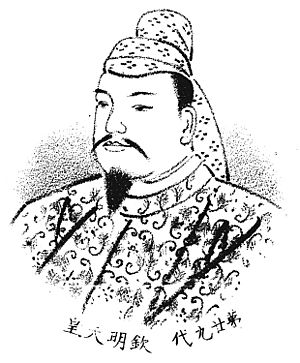Emperor Kinmei facts for kids
Quick facts for kids Emperor Kinmei欽明天皇 |
|||||
|---|---|---|---|---|---|
 |
|||||
| Emperor of Japan | |||||
| Reign | December 5, 539 – April 15, 571 | ||||
| Predecessor | Senka | ||||
| Successor | Bidatsu | ||||
| Born | 509 Japan |
||||
| Died | 15 April 571 (aged 62) Asuka, Yamato |
||||
| Burial | Hinokuma no saki Ai no misasagi (檜隈坂合陵) (Nara) | ||||
| Spouse | Ishi-hime | ||||
| Issue among others... |
|||||
|
|||||
| House | Imperial House of Japan | ||||
| Father | Emperor Keitai | ||||
| Mother | Princess Tashiraka | ||||
| Religion | Shinto | ||||
Emperor Kinmei (欽明天皇, Kinmei-tennō, 509–571) was the 29th Emperor of Japan. He ruled from 539 to 571. Some historians believe Kinmei was the first Japanese Emperor whose rule is supported by strong historical evidence.
Contents
Emperor Kinmei's Reign
During Kinmei's time, the title "tennō" (Emperor) was not yet used. Instead, he was likely called Sumeramikoto or Amenoshita Shiroshimesu Ōkimi. This means "the great king who rules all under heaven." He might also have been known as the "Great King of Yamato."
Becoming Emperor
Emperor Kinmei became ruler after his older brother, Emperor Senka, passed away in 539. Kinmei was the third son of Emperor Keitai. He set up his royal court at Shikishima no Kanazashi Palace in Yamato.
Important Advisors
Emperor Kinmei had several important advisors who helped him rule:
- Ōomi (Great Imperial Chieftain): Soga no Iname.
- Ōmuraji (Great Deity Chieftain): Mononobe no Okoshi.
- Ōmuraji (Great Deity Chieftain): Ōtomo no Kanamura.
Start of the Asuka Period
Even though the main court moved to the Asuka region later, some people consider Emperor Kinmei's rule the start of the Asuka period. This is especially true for those who connect the Asuka period with the arrival of Buddhism in Japan.
Buddhism Arrives in Japan
A very important event during Emperor Kinmei's reign was the official introduction of Buddhism to Japan. In 552, the king of Baekje (a kingdom in ancient Korea), King Song Myong, sent a bronze statue of Gautama Buddha as a gift. He also sent many skilled workers, monks, and other items. This moment is often seen as when Buddhism truly began in Japan.
However, some records say Buddhism arrived a bit earlier, in 538.
Religious Differences
The arrival of Buddhism caused a big disagreement in the court. The Mononobe clan wanted to keep worshipping Japan's traditional gods, called kami. But the Soga clan supported the new religion, Buddhism. This difference in beliefs led to tension between the two powerful clans.
Emperor Kinmei's Burial
Emperor Kinmei ruled until he died in 571. He was buried in the Hinokuma no Sakai Burial Mound. However, another strong idea is that he was actually buried in the Misemaruyama Tumulus, located in Kashihara City.
Today, the Emperor is honored at a Shinto shrine in Nara. This place is called Hinokuma no saki Ai no misasagi.
Emperor Kinmei's Family
Emperor Kinmei's father was Emperor Keitai. His mother was Princess Tashiraka, who was the daughter of Emperor Ninken. During his life, Kinmei was known by the name Amekuni Oshiharaki Hironiwa.
Emperor Kinmei had six wives and 25 children. He had 16 sons and 9 daughters. Interestingly, his first three wives were his nieces, who were daughters of his half-brother Emperor Senka. Two other wives were sisters, daughters of his chief advisor, Soga no Iname.
- Empress: Ishi-hime, daughter of Emperor Senka
- Prince Yata no Tamakatsu no Ōe
- Prince Nunakura Futotama-Shiki, who later became Emperor Bidatsu
- Princess Kasanui
- Consort: Princess Wayaka-Hime, daughter of Emperor Senka
- Prince Iso no Kami
- Consort: Princess Hikage, daughter of Emperor Senka
- Prince Kura
- Consort: Soga no Kitashihime, daughter of Soga no Iname
- Imperial Prince Ogetaroinogushiwamikoto, who later became Prince Shōtoken
- Imperial Princess Iwakuma-hime
- Prince Atori
- Princess Ishiroi-Hime, who later became Empress Dowager Kitano-Hime and married Emperor Bidatsu
- Prince Maroko
- Princess Ohoyake
- Prince Iso no Kami Be
- Prince Yamashiro
- Princess Ohotomo
- Prince Sakurai
- Princess Katano
- Prince Tachibana Moto no Wakugo
- Princess Toneri
- Emperor Yōmei
- Consort: Soga no Oane, daughter of Soga no Iname
- Prince Umaraki
- Prince Kazuraki
- Princess Hasetsukabe-no-Anahobe-no-Hashihito
- Prince Amatsukabe Anahobe
- Prince Kōshiko
- Prince Yakabe
- Consort: Nukako, daughter of Kasuga no Hifuri no Omi
- Princess Kasuga no Yamada
- Prince Tachibana no Maro
See also
 In Spanish: Kinmei Tennō para niños
In Spanish: Kinmei Tennō para niños

